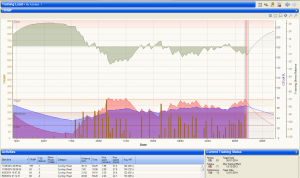What is Trending?
Trending, when used in a pharmaceutical microbiology laboratory, is the examination of long term data in order to examine if a controlled process is moving away from the state of control. Trending can also be used to determine the stability of a product’s efficacy by examining the results of testing over time. Stability trends are important to support expiry dates and storage conditions.
What is Trending Used For?
Trending within the context of a pharmaceutical manufacturing plant is used to examine the ongoing state of rooms associated with the manufacture of drugs. Routine environmental monitoring is tabulated and graphed in order to examine if counts of microbes are moving away from the numbers normally seen. This is done in order to determine if an area currently within a ˜state of control” is moving away from being controlled.
Trending is also used to determine if the established alert and action levels are appropriate. As discussed in another post (VEM) , such limits are used to indicate a drift from normal operation. If a production plant is in such a state of control where the action or alert limits are infrequently breached, trends can be used to lower the levels to a point where, say, 1/100 samples will return an alert or action state.

Trends from a production support room
The microbial recovery trends from the room above indicate the alert and action levels can be tightened.
Trending is used in lots of places outside of drug manufacture. Financial analysts use it, social media talks of “what’s trending”, climate scientists have demonstrated an upward trend in global temperatures. Some athletes use trends calculated from their training in order to ensure they are in peak condition for events they wish to do well in.

Example of a cyclist’s training balance over a 3 month period.
In the chart above, an athlete’s best performances are achieved when both form, and fitness are at their maximum.
What constitutes a Trend?
A trend is a set of data that is moving consistently in one direction. A good trend for microbiological data, is to have viable microbe recovery on a graph heading down. A microbiology laboratory trends such things as:
- purified water data
- microbial recovery from clean rooms
- the types of microbes recovered (here, is a certain microbe is recovered frequently, it is a good idea to add it to the list of microbes used when validating product recovery tests)
- which microbes tend to produce sterility failures
- room temperatures vs recoveries
What is an adverse trend?
An adverse trend, as the name implies, is a trend that is unwanted. This is a trend towards an undesired condition over a specified number of sampling periods. An adverse trend may be a series of trends that are below an alert level, but combined, indicate that a state of control has been lost. If an adverse trend is ignored, the action level is likely to soon be breached. Actioning an adverse trend reduces the likelihood that the state of control will deviate sufficiently to result in major product investigations that cost companies time, money and potentially lost sales and customers.
Appendix:
Did you find this informative or useful? Please consider a small donation so I can expand and improve on what I deliver.
